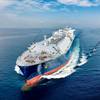By Ed Walsh, Office of Naval Research Public Affairs
As hybrid electric cars become more commonplace on America’s highways, the Navy is working to bring hybrid electric ships to the high seas. The Office of Naval Research (ONR) is developing innovative propulsion systems based on new fuel-cell technology for efficient generation of electrical power and greater design flexibility for future ships.
To ensure a relatively quick transition to this promising technology, ONR is funding development of a method to extract hydrogen from diesel fuel. A diesel reforming system would take advantage of the relatively low cost of the fuel and the Navy’s established infrastructure for buying, storing and transporting it.
Unlike gas turbines and diesel engines, fuel cells do not require combustion, and therefore do not produce pollutants such as nitrogen oxide. Fuel cells are also far more efficient than combustion engines. ONR Program Officer Anthony Nickens explains that “the Navy’s shipboard gas turbine engines typically operate at 16 to 18 percent efficiency, because Navy ships usually sail at low to medium speeds that don’t require peak use of the power plant. The fuel cell system that ONR is developing will be capable of between 37 to 52 percent efficiency.”
Moreover, fuel cells will permit design of a “distributed” power system, since unlike conventional engines, they can be dispersed throughout the ship instead of being co-located with the ship’s shaft. This added flexibility will improve ship survivability.
Nickens says that the Navy’s DD(X) land-attack destroyer program is very interested in fuel cell technology as a supplemental power source. Fuel cells combine improved efficiency, low emissions and design flexibility, all of which help slash shipbuilding costs—-a bottom-line goal of the Navy’s current “transformation” efforts.
ONR is testing a 500-kilowatt diesel fuel reformer, or integrated fuel processor, that is compatible with a proton exchange membrane (PEM) fuel cell, at the Department of Energy Idaho National Engineering and Environmental Laboratory in Idaho Falls. Reforming diesel is especially tricky due to the sulfur present in the fuel. The integrated fuel processor heats and vaporizes the diesel, then the sulfur in it is converted into hydrogen sulfide. The hydrogen sulfide is then exposed to zinc oxide, oxidizing the sulfur into sulfur dioxide and separating it from the hydrogen.
The testing will continue through June 2004 to prove out the reforming process. Meanwhile, ONR is looking at design approaches to reduce the size of the processor, which consists of an arrangement of valves, water-gas shift reactors, an oxidizer and other components, so that it won’t take up too much space aboard a Navy ship.
Subscribe for
Maritime Reporter E-News
Maritime Reporter E-News is the maritime industry's largest circulation and most authoritative ENews Service, delivered to your Email five times per week










